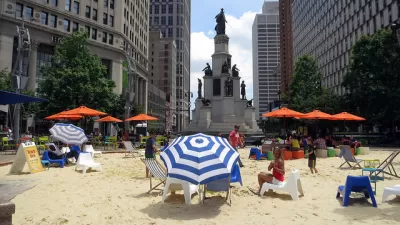Since 2004, the Next Generation of New Urbanists (NextGen) has welcomed new ideas and new faces into the Congress for the New Urbanism.
Since 2004, the Next Generation of New Urbanists (NextGen) has welcomed new ideas and new faces into the Congress for the New Urbanism. Comprised of a core group of leaders, generally between ages 25 and 40, the NextGen focuses on pushing the principles of new urbanism, as defined in the Charter, forward.
Beyond providing a barrier-free entrée point to the CNU, the loose organization's main thrust is to recognize that the impressive accomplishments of the 30-year old new urbanist movement has created a false sense that the challenges CNU initially sought to conquer have, well, been conquered. To be sure hundreds of projects, an expansive body of unified research, and dozens of related organizations continue to solidify a planning reform movement that dates to the beginning of the American municipal planning profession.
Today, the wide acceptance of peak oil, global warming, and the recent economic crisis-issues new urbanism tackle head on-provides an added boost, if not a sense of urgency.
But while progressive planning efforts continue to revive a normative trajectory of city building- one found before the meteoric rise of petroleum-based planning-it's increasingly obvious that translating great principles, design manuals, built projects, and innovative zoning codes into truly great places is still not done easily.
With this in mind, 17 core NextGen leaders convened in New Orleans' Marigny/Bywater neighborhood this past November to discuss the future of urbanism and the role CNU should play in continuing the project of town and city making.
As attendees began to trickle into the Big Easy, the diversity of the movement quickly became apparent: the CNU's founding members are primarily architects from the babyboom generation, while the NextGen's leadership-and the Congress as a whole-is now comprised of zoning attorneys, planners, business strategists, marketing experts, engineers, landscape architects, urban designers, developers, students, and yes, plenty of architects. This professional diversity differentiates the movement from other planning or building organizations, and is a testament to CNU's unique, interdisciplinary approach.
The weekend of intense, intelligent discussion began with each attendee presenting a 20-slide, 6:40 Pecha Kucha presentation. While each presenter laced the wall of the Bywater house in which we crammed with new ideas, criticism, and goals, not one topic was repeated. Yet, the common thread of improving the efficacy of the CNU, and the general livability of our cities, was found throughout.
After the presentations, everyone broke into smaller working groups to push a number of initiatives forward. Central among these is translating each Charter principle into the first person, i.e, putting the onus back on individual to take personal responsibility in creating sustainable buildings, streets, neighborhoods, districts, corridors, towns, cities, and regions. Other initiatives include improving the annual Congress experience, improving communication to those outside of the CNU movement, expanding our research initiatives, and continuing the transitioning of the the organization's founders, who are now reaching their '60s.
All set to the backdrop of New Orleans' joi de vivre, it was a pretty good weekend.
Fast-forward to today, the NextGen has been busy pushing each of the identified initiatives forward. Central to the effort is a new strategic plan guiding the ongoing development of the NextGen and the continued evolution of the new urbanism. To this end, two products supporting this effort are now available.
The first is the beta version of an open source project, called Tactical Urbanism: Short TermAction || Long Term Change. Authored by yours truly, with Dan Bartman, Ronald Woudstra, and Aurash Khawarzad, the report covers a variety of initiatives utilizing a less formal, but dynamic approach to improving our neighborhoods and cities.
And in further support of CNU 19, which is happening in Madison, Wisconsin this year, NextGen has organized AuthentiCity, a design competition targeting an infill site. Please have a look at the competition page, and spread it around to those who may be interested in submitting an entry.
While the new urbanism is not so new anymore, it is still full of talented, passionate, and driven people committed to the movement's principles. For those who attended the Bywater/Marigny retreat, the new urbanism is now morphing into the Next Urbanism, which will continue to build from the extraordinary effort led by those who came before us.
If interested, please join the discussion in Madison. We have a lot of work to do.

Maui's Vacation Rental Debate Turns Ugly
Verbal attacks, misinformation campaigns and fistfights plague a high-stakes debate to convert thousands of vacation rentals into long-term housing.

Planetizen Federal Action Tracker
A weekly monitor of how Trump’s orders and actions are impacting planners and planning in America.

In Urban Planning, AI Prompting Could be the New Design Thinking
Creativity has long been key to great urban design. What if we see AI as our new creative partner?

King County Supportive Housing Program Offers Hope for Unhoused Residents
The county is taking a ‘Housing First’ approach that prioritizes getting people into housing, then offering wraparound supportive services.

Researchers Use AI to Get Clearer Picture of US Housing
Analysts are using artificial intelligence to supercharge their research by allowing them to comb through data faster. Though these AI tools can be error prone, they save time and housing researchers are optimistic about the future.

Making Shared Micromobility More Inclusive
Cities and shared mobility system operators can do more to include people with disabilities in planning and operations, per a new report.
Urban Design for Planners 1: Software Tools
This six-course series explores essential urban design concepts using open source software and equips planners with the tools they need to participate fully in the urban design process.
Planning for Universal Design
Learn the tools for implementing Universal Design in planning regulations.
planning NEXT
Appalachian Highlands Housing Partners
Mpact (founded as Rail~Volution)
City of Camden Redevelopment Agency
City of Astoria
City of Portland
City of Laramie






























